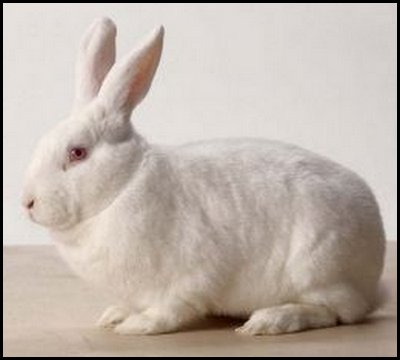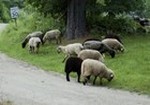Raising Rabbits for Profit - All you need to Know about Feeding, Cages and Care

Raising rabbits for meat and fur is a good way to make money but only if you do it on a large scale, and it should be done as supplementary income only. The initial costs in setting-up is small, rabbits breed quickly and frequently, they have large litters and grow to a good marketable size in a very short time. However, it is a full time job with daily rabbit care and good feeding needed.
Successful Rabbit Raising means Determining a Market
Like any business, if you are wanting to make a profit with rabbits you really need to assess the market. Do your homework first, before making an investment to see if there is a market and where the market is. Is there a market for rabbit meat, rabbit fur or both?
Once you have established whether there is a market or not, find out where you will be able to slaughter the animals. Some slaughter houses will expect you to transport the live animals to them. And sometimes you can find a local butcher who will be able to slaughter and dress the rabbits.
Rabbit Raising and Choosing the right Rabbit Breed
Although there are more than 60 rabbit breeds and varieties, most of these can be divided into 3 different groups:
- 1. Small Breeds that weigh little than a 2 pounds fully grown, such as the Polish rabbit.
- 2. Medium Breeds that have an average adult weight of about 10 pounds. Rabbits in this category are the New Zealand, California and Palomina.
- 3. Large Breeds that have an average adult weight of 14 pounds.
Good Dual-Purpose Rabbit Breeds
One of the most popular rabbits for raising rabbits on a commercial scale is the New Zealand white rabbit, which is not from New Zealand, despite its name, but from America. It has good white fur and a good percentage of flesh to bone. Therefore the New Zealand White is a good dual-purpose rabbit. Other good dual-purpose rabbits are the American Chinchilla and the Californian Rabbit.Rabbit Breeds for Fur
For those raising rabbits for their fur then the Angora Rabbit and the Rex Rabbits are breeds that are best suited for this purpose and fetch good prices, especially the Chinchilla Rex and other Rex breeds like the Castor Rex and the White Rex Rabbits.One thing to remember though is that where the turn around time for meat rabbits is about 2 months, fur rabbits are kept for 3-5 months before being slaughtered.
Rabbit Raising and Look for Good Rabbit Breeding Stock
Your New Zealand white rabbit should have a low set body, deep shoulders, and short neck, legs and ears.
Your rabbits will continue to make
money for you as long as you maintain good breeding stock.
Therefore,
not all your rabbits will be sent to the slaughter house. Your breeders
will soon need replacing and your litters should be examined for
breeding potential. These then should be kept back and used as breeding
stock when you need to replace or increase your stock.
Rabbit Raising, The Doe and her Kittens
A good New Zealand white doe can be bred at the age of 6 months and if conditions are ideal she can be bred 4 times a year. Breeding does are usually kept for 2 years before they are slaughtered. On average they can give birth to 80 young a year. The buck may be bred up to 7 times a week effectively. He can be used for mating at the age of 7 months.
The young are born within 28–31 days of mating and a normal rabbit litter is around 6-8 kittens but can range from two to twelve. The rabbits should be kept until they weigh about 1.8-2 kg each before sent to be butchered. This normally takes about 2 months. However, one should also be aware that by the time the rabbit is butchered and dressed it will have lost about 33% of its original weight. The bigger the breed, the more loss there will be, sometimes as much as 45%. Therefore a 3 kg rabbit before being butchered will weigh about 2 kg after being butchered.
The other advantage of raising rabbits is that they can be bred throughout the year bringing a steady income. A person on their own with no extra help can easily manage to look after 500 does. However, most people who raise rabbits for profit as a backyard venture operate much smaller farms. However, even working with 100 does will bring in a healthy and steady monthly income.
Just because you are raising rabbits for profit doesn't mean that don't have to give them the same treatment you would if it were a pet. In fact, because these animals are the lynch pin to your profit they should be given extra care and attention. The most important is of course housing and food.
Rabbit Raising and Housing your Rabbits
Housing will probably be your most expensive outlay. There is always the possibility of buying second hand cages, or making your own. There are some rabbit breeders who hang the cages in unused sheds, and others who place the cages outside, under some old tree. However, if you are serious about raising rabbits for meat and profit, then you should think about raising them in a controlled environment, as this will give you a better feed-to-meat conversion.
Rabbits need plenty of light and fresh air. Their hutches can be simple structures of wood and wire. One problem with wood however, is that many rabbits who have a close encounter with wood are susceptible to ear mites.
Rabbits should have a roof that protects them from the sun as a rabbit's fur should not be exposed to the sun if you are raising rabbits for fur. Also, there should be a canvas curtain that can be dropped over the cases to prevent chilling winds and rain from entering. In the hot summer months a sprinkler system can be placed on the roof to cool the hutches down.
The rabbit hutches should be 10 feet square in space for each rabbit. Individual hutches can be made using the following dimensions: 4 ft x 2.5 ft x 2 ft. If you live in area where you have cold winters then the top, sides and backs should be built of wooden board to give added protection. If, however, you live in a warm climate you will need to give your rabbits better circulation and to take advantage of any breeze.
The cages here can be made out of wire netting on all sides. Using a 1 inch wire netting is sufficient. The floor of the cages should be 1/2 inch metal hardware cloth that allows the rabbit stability when walking and allows for the droppings and urine to fall through to the ground. The smaller diameter holes is also important for rabbit safety, as bigger holes can result in baby rabbits breaking their legs if they end up slipping through the bigger gaps in the netting.
Having a floor like this on the cages allows for the rabbits to be free from most diseases as they are in clean, sanitary conditions.
Anything made to house your rabbits should be strong enough to protect them against predators and the elements. This is especially important when a doe has kittens. Any nervous doe faced with danger may end up standing all over kittens and killing them.
Raising rabbits has an excellent by-product for your garden and veggie patch! Rabbit manure is very good for the compost heap and for growing vegetables and so it is advisable to buy or make deep metal trays and place these directly under the cages. This then makes for easy cleaning and easy transportation of the manure to the compost heap when they are full. Cleanliness is vital for good rabbit raising.
When the young rabbits have reached the age of 8-10 weeks of age they will need to be separated and placed in individual cages. This is to prevent the rabbits from fighting, as they will if you don't separate them.
Rabbit Raising and Breeding Boxes
When raising rabbits your breeding does should have their own nesting boxes. These rabbit nesting boxes should be 1 1/2 feet long, 1 foot wide and 1 foot high. There should be a 7 inch door cut in the box which is cut 5 inches from the bottom. This then prevents the young rabbits from falling out of the boxes.
You will know when your doe is needing her nest box when she starts pulling the fur from her dewlap. She will also take the hay that you are feeding her to create a nest.
When the kittens are born they are hairless and born with their eyes closed. Fur begins to grow in by day 5 or 6 and after 10 to 12 days their eyes will open. At the age of three weeks their mother will begin to wean them off milk and they will then begin to eat hay and pellets.
Rabbit Raising and What and What not to Feed your Rabbits
Greens:
Rabbits eat a lot of grass and leaves, but any food given to them should never be placed on the bottom of the cages in case they peed on or pooped on. A manger should be built for each cage that would allow the food to be kept under sanitary conditions.
If you are not able to build managers, then the food should be placed in bundles and then hung from the sides of the cage, allowing the rabbits to help themselves when hungry. Any wire or string used to do this should be short pieces to prevent the rabbits from coming to any harm.
They should be fed twice a day and greens and water are the basis to your rabbit's diet but if you introduce anything new to your rabbits do it slowly, as their digestive systems can become upset.
Not all greens are good for rabbits. Never feed them lettuce. Lettuce contains lactucarium, which can give your rabbit diarrhea so badly that it can become fatal. Other common foods to avoid include cabbage, parsnips, swedes, potato tops, and tomato leaves.
Hay should be given as part of their diet. It should be well dried and free of mold. Alfalfa, clover and even peanut hay is acceptable. Oats, wheat, barley and corn can also be fed to give a more balanced diet, with occasionally small amounts of sulfur, charcoal and cod liver oil.
Watch rabbits though! They are very crafty animals and will favor barley and wheat over corn. Rabbits also like carrots and should be fed the odd one now and again. Finally, a block of salt should be placed in each hutch so that the rabbit can nibble on it when needed.
Water:
Water is very important and they should never be without. It must be replaced daily and using an automatic water container is usually the best option which can be fixed to the cages.Rabbit Illnesses
If your rabbit hutches are kept clean and they are fed properly they will suffer from few illnesses, especially when compared to other livestock. However, there are 2 illnesses that can occur with raising rabbits and that is the snuffles and coccidiosis which is a worm infection that chickens also suffer from.
Any rabbit that has either of these 2 diseases should be destroyed immediately and their hutches thoroughly sanitized and sterilized to prevent the rest of your rabbits from contamination.
Rabbit Raising and How Profitable is It?
When you start with rabbits you will soon realize that it doesn't take long to increase your stock. If you started with just 2 doe and 1 buck you could soon have 50 rabbits or more after the 1st year. If you had 50 - 150 does, this would definitely mean a steady source of income and would also take up a substanial amount of time during the day for their care.
People are beginning to see that rabbit meat is good for you. It may be firmer than chicken, but the taste is very similar. Rabbit meat is high in protein and low in fat and calories.
Not only can one use these animals for their meat, but another by-product is their fur. The pelts can be used to make a number of items such as slippers, fur trimmed garments, hats etc.
Rabbit manure is also highly valued, and can be bagged and sold to gardeners. It is rich in nitrogen and phosphorus. The beauty of using rabbit manure on plants is that it can be used straight away without having to worry about whether it will burn the plants after application.
At one stage, farmers in Europe were getting 2 Euros a kilo for their rabbit meat, which they considered to be a good price. When you have a dual-purpose rabbit like the New Zealand white rabbit then the sale of those pelts can range from anywhere from 15-50 cents depending on who your market is. However, the Chinchilla Rex commands the most money. Next comes the Castor Rex and then the White Rex.
One has to remember too that when the kittens are born you will also suffer losses. Many rabbit breeders expect losses of 25%. Rex animals are more difficult to breed and their average litter is about 6 kittens. Their conditions are different too. They have to be kept in separate cages to protect the fur. They are sent to slaughter in individual boxes and their slaughtering is done manually and slowly so as not to damage the fur.
In the USA, meat is sold at various prices, depending on where you live. On average, however, at 2013 prices, rabbit meat can be sold retail for $6 -8 a pound, dressed.
Rabbit Raising; Conclusion
Raising rabbits is a pleasurable experience. Success to raising rabbits for profit are determined by 3 things:
- A good breeding program
- Proper equipment
- Good care
However, with all food products there are rules and regulations that you will need to abide by set by your local council body. Make sure that you know these before you decide to go into raising rabbits for meat.
There could also be zoning restrictions involving keeping rabbits and/or selling rabbit pelts, if you are not in an agricultural zone for keeping rabbits, or an industrial zone if you are treating the pelts. Always check.
We hope that raising rabbits for you means making a profit in the future!
See more information on breeding rabbits and raising
colony rabbits.
Raising Rabbits Videos
Part 1 of the series on raising rabbits looks at equipment needed for rabbit raising as well as helpful hints in getting started. This series has been in the works for six months as they have tried to capture video of kits at various ages and stages of growth.
This new series is about raising rabbits for MEAT, i.e, to EAT. Be forewarned that we will discuss rabbit raising in that format and later videos will show some butchering - with a warning before it actually comes up. So for the PETA crowd, men of the other gender and the "we won't eat anything with eyes" crowd, you'll probably want to skip these videos.
Some Homesteading Books for you on Raising Rabbits
You can Add your Own Comments on Raising Rabbits!
We have lots of pages where you can contribute to throughout this website. We love hearing from our readers, and hope you will be one of those we hear from too. Feel free to add your own comments and experiences on raising rabbits. Just type in the form below, we will do the rest.
Leave a Comment
Do you have anything that you would like to add after reading this page? We would love to hear your thoughts. If you can add additional information to what has been written here you will be adding value to the website! No need to have any special skills - just type and submit. We will do the rest!
Other Comments
Click below to see comments from other visitors to this page...
Rabbit Breeding and Incest 




Can you breed brother and sister or parent and child New Zealand Whites?
***
Adam, the inbreeding of rabbits is an acceptable practice where …
I Want to start rabbit farm in Nepal 




I read above about rabbit farming & benifits. So I want to humbly request Nepal is also a beautiful country and a good environment for rabbit farming. …
RABBIT FARMING IN ALBERTA CANADA Not rated yet
Is there a market for rabbit in Alberta?
***
Chris, local knowledge is vital when determining whether there is a huge demand for rabbit meat. …
rabbit farming Not rated yet
Nepal is a beautiful country and a good environment for rabbit farming. So for the first time in Nepal I want to start a large scale of rabbit farming …
want rabbits Not rated yet
I love rabbits i want good breed of rabbits. Is there anyone out there who can help?
Follow Us: Facebook, Twitter, Google+, Pinterest, RSS
 |
 |
 |
Don't miss out on our latest news and articles. Sign up for our free monthly e-zine!
OTHER SECTIONS OF INTEREST
Breeding Rabbits for Meat, Profit or Fun

Click Here




New! Comments
Do you have something of value to add? Leave me a comment in the box below.